RAF Tangmere
| RAF Tangmere | |||||||||||||||
|---|---|---|---|---|---|---|---|---|---|---|---|---|---|---|---|
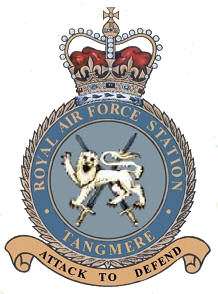 Station crest | |||||||||||||||
| IATA: none – ICAO: none | |||||||||||||||
| Summary | |||||||||||||||
| Airport type | Military | ||||||||||||||
| Operator | Royal Air Force | ||||||||||||||
| Location | Tangmere | ||||||||||||||
| Coordinates | 50°50′45″N 000°42′23″W / 50.84583°N 0.70639°WCoordinates: 50°50′45″N 000°42′23″W / 50.84583°N 0.70639°W | ||||||||||||||
| Map | |||||||||||||||
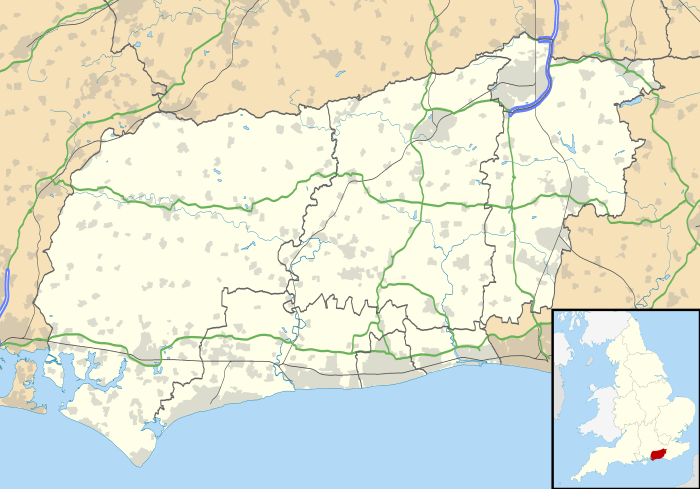 RAF Tangmere Location in West Sussex | |||||||||||||||
| Runways | |||||||||||||||
| |||||||||||||||

RAF Tangmere which was in Tangmere, 3 miles (5 km) east of Chichester, West Sussex, England, was a Royal Air Force station famous for its role in the Battle of Britain. Famous Second World War aces wing commander Douglas Bader, and the then inexperienced Johnnie Johnson were at Tangmere in 1941.
History
First World War
The aerodrome was founded in 1917 for use by the Royal Flying Corps as a training base. In 1918 it was turned over to the American Air Force as a training ground, and continued as such until the end of the Great War in November of that year, after which the airfield was mothballed.
In 1925 the station re-opened to serve the RAF's Fleet Air Arm, and went operational in 1926 with No. 43 Squadron equipped with biplane Gloster Gamecocks (there is still a row of houses near the museum entrance called Gamecock Terrace).
Second World War
As war threatened in the late thirties, the fighters became faster, with Hawker Furies, Gloster Gladiators, and the Hawker Hurricanes powered by the famous Merlin engines all being used at Tangmere. In 1939 the airfield was enlarged to defend the south coast against attack by the Luftwaffe, with Tangmere's only hotel and some houses being demolished in the process. The RAF commandeered the majority of houses in the centre of the village, with only six to eight families being allowed to stay. It was only in 1966 that the village resumed its status as a civilian community.
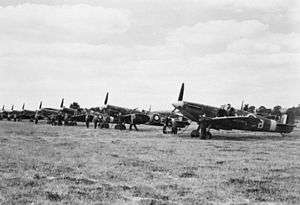
In August 1940 the first squadron (No. 602 Squadron RAF) of Supermarine Spitfires was based at the satellite airfield at nearby Westhampnett, as the Battle of Britain began. By now the villagers had mainly been evacuated, and extensive ranges of RAF buildings had sprung up.
The first and worst enemy raid on the station came on 16 August 1940 when hundreds of Stuka dive bombers and fighters crossed the English coast and attacked Tangmere. There was extensive damage to buildings and aircraft on the ground and 14 ground staff and six civilians were killed, but the station was kept in service and brought back into full operation.
Throughout the war, the station was also a secret base for the Special Operations Executive who used the Westland Lysander to fly agents in and out of occupied France for the Resistance. The SOE used Tangmere Cottage, opposite the main entrance to the base. Today the cottage sports a commemorative plaque to its former secret life.
Later in the war, as the RAF turned from defence to attack, the legendary Group Captain Douglas Bader, the legless fighter ace, commanded the Tangmere wing of Fighter Command. Today he is commemorated in the Bader Arms public house in the village. 616 Squadron which included Johnnie Johnson and Hugh Dundas arrived at Tangmere in late February 1941.[1] Johnson went on to become the highest scoring Western Allied fighter ace against the Luftwaffe.
Many of those killed at the base, from both sides in conflict, are buried in the cemetery at St Andrews Church, Tangmere, today tended by the Commonwealth War Graves Commission. American RAF pilot Billy Fiske who died at Tangmere in 1941 was one of the first American aviators to die during the Second World War.
Postwar
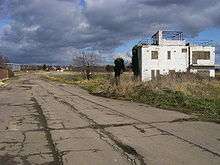
After the war, the RAF High Speed Flight was based at Tangmere as part of Central Fighter Establishment. In September 1946, a world air speed record of 616 mph (991 km/h) was set by Group Captain Edward "Teddy" Mortlock Donaldson in a Gloster Meteor; after his death in 1992, he was buried in St Andrews Church. In September 1953, Squadron Leader Neville Duke became holder of the world air speed record when he flew a Hawker Hunter at 727 mph (1,170 km/h) – the 50th anniversary of this event was commemorated in 2003. No 38 Group Tactical Communications Wing RAF and 244 Signal Squadron (Air Support) were the last units to leave the base, relocating to RAF Benson.
In the late 1950s the flying was restricted to ground radar calibration and the Joint Services Language School moved there. Amongst those taking a one-year course was Richard Marquand, better known as being the director of the Star Wars film "The Return of the Jedi". In 1960 the station was granted the "Freedom of Chichester" and the event was marked by a march through the town and service in the Cathedral.
Some of the last flying units to be based at the station included:[2]
- No. 245 Squadron RAF (25 August 1958 - 19 April 1963) (Canberra B.2, disbanded by renumbering to No. 98 Squadron, 19 April 1963).
- No. 98 Squadron RAF (19 April - 1 October 1963) (moved to RAF Watton)
- No. 115 Squadron RAF (25 August 1958 - 1 October 1963)
- 'B' Flt, No. 22 Squadron RAF (June 1961 - May 1964)
In 1963-64 the last flying units left. The station finally closed on 16 October 1970; a single Spitfire flew over the airfield as the RAF ensign was hauled down.
Present use
Following the closure of the RAF station, some of the land around the runways was returned to farming. Tangmere Airfield Nurseries have built large glasshouses for the cultivation of peppers and aubergines.
Until 1983 37 acres (150,000 m2) of barracks, admin blocks and repair workshops remained derelict until bought by Seawards Properties Ltd. Housing soon spread around the airfield, and much RAF building was demolished and officers' houses retained as homes. However, a few original RAF buildings remain, including three T.2 type hangars, the Control Tower, fire station, NAAFI/Airmen's Institute and one of the ‘H Block’ accommodation buildings.
The majority of the airfield is now farmed, and since 1979 the runways have slowly been removed thus returning the whole airfield back to large scale farming once again. The derelict control tower forms part of the farm but is now bricked up and partly overgrown.
Tangmere Military Aviation Museum
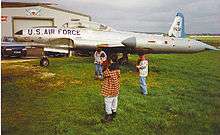
Tangmere Military Aviation Museum was founded by a group of enthusiastic veterans. It has a replica Supermarine Spitfire and Hawker Hurricane as well as many original aircraft, including Neville Duke's speed record Hawker Hunter. On display is the 'Star' Meteor flown by Teddy Donaldson when he set the World Air Speed Record in September 1946, breaking the 1,000 km/h barrier.[3]
Bus number 55 runs from Chichester bus station to the museum throughout the day, including Sundays.
34067 locomotive
A number of Oliver Bulleid's light pacific locomotives were named after Battle of Britain squadrons, stations, or commanders. One such locomotive that is preserved and still in main line operation is named "Tangmere" (no 34067).
See also
References
- ↑ Sarkar, Dilip. Spitfire Ace of Aces: The True Wartime Story of Johnnie Johnson. Amberley Publishing, 2011. ISBN 978-1-4456-0475-6 page43
- ↑ http://rafweb.org
- ↑ Thomas, Nick. RAF Top Gun: Teddy Donaldson CB, DSO, AFC and Bar Battle of Britain Ace and World Air Speed Record Holder, Pen & Sword, 2008. ISBN 1-84415-685-0
External links
| Wikimedia Commons has media related to RAF Tangmere. |
